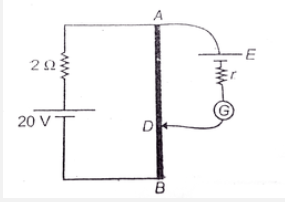
While doing an experiment with potentiometer (figure) it was found that the deflection is one sided and (i) the deflection decreased while moving from one and A of the wire, to the end R, (ii) the deflection increased, while the jockey was moved towards the end D.
(i). Which terminal positive or negative of the cell E1 is connected at X in case (i) and how is E1, related to E?
(ii). Which terminal of the cell E1 is connected at X in case (1 in 1)?
(i) the deflection in galvanometer is one sided and the deflection decreased, while moving from one end 'A' of the wire to the end 'B' Thus imply that current in auxiliary circuit (lower circuit containing primary cell) decreases, while potential difference across A and jockey increases.
This is possible only when positive terminal to the cell E1, is connected at X and E1>E.
(ii). The deflection in galvanometer is one sided and the deflection increased, while moving from one end A of the wire to the end B, this imply that current in auxiliary circuit (lower circuit containing primary cell) increases, while potential difference across A and jockey increases.
This is possible only when negative terminal of the cell E1, is connected at X.
Topper's Solved these Questions
- CURRENT ELECTRICITYBOOK - NCERT EXEMPLAR ENGLISHCHAPTER - CURRENT ELECTRICITYEXERCISE - MCQs (More than one options)
5 Videos
- COMMUNICATION SYSTEMBOOK - NCERT EXEMPLAR ENGLISHCHAPTER - COMMUNICATION SYSTEMEXERCISE - LONG ANSWER TYPE QUESTIONS
5 Videos
- DUAL NATURE OF RADIATION AND MATTERBOOK - NCERT EXEMPLAR ENGLISHCHAPTER - DUAL NATURE OF RADIATION AND MATTEREXERCISE - LONG ANSWER TYPE QUESTION
5 Videos
Similar Questions
While doing an experiment with potentiometer (see figure) it was found that the deflection is one sided and (i) the deflection decreased while moving from one and A of the wire, to the end R, (ii) the deflection increased, while the jockey was moved towards the end D.
(a)Which terminal positive and negative of the cell E1 is connected at X in case (i) and how is E1 related to E ?
(b)Which terminal of the cell E1 is connected at X in case (i in a) ?

View SolutionWhich one of the following does not increase while moving down the group of the periodic table ?
View SolutionThe deflection in a moving coil galvanometer is
View SolutionIf a positively charged particle is moving as shown in the figure, then it will get deflected due to magnetic field towards

View SolutionIn a hot wire ammeter the deflection angle θ of the pointer is related with the current I as
View SolutionThe potentiometer wire AB shown in figure is 50cm long.When AD=30cm, no deflection occurs in the galvanmeter.Find R.

View SolutionAn electron does not suffer any deflection while passing through a region of uniform magnetic field. What is the direction of the magnetic field ?
View SolutionIn the potentiometer circuit shown the galvanometer shows no deflection for AD = 35 cm. The resistance of wire AB is 18 Ω and its length is 50 cm . Calculate the emf E of the cell

View SolutionThe locus of the centre of the circle for which one end of the diameter is (3,3) while the other end lies on the line x+y=4 is
View SolutionThe potentiometer wire AB shown in figure is 40cm long. Where the free end of the galvanometer should be connected on AB so that the galvanometer may show zero deflection?

View Solution
